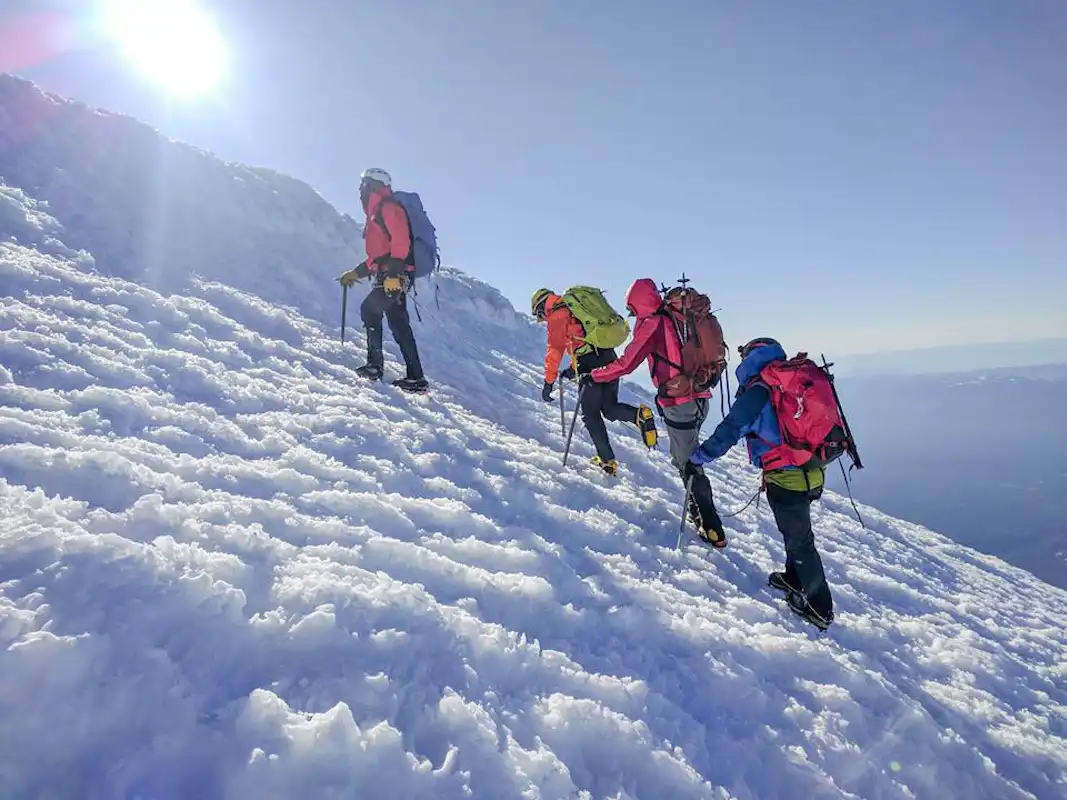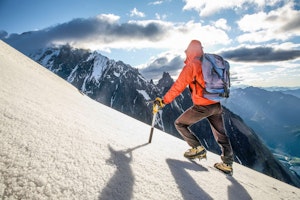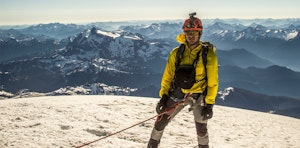Towering over Interstate 5 in northern California, Mt Shasta casts an imposing shadow out over its surroundings. At 4.322 meters in elevation the dormant stratovolcano is the second highest peak in the Cascade Range and the fifth highest in California.
The mountain is composed of four overlapping volcanic cones, which gives it a massive and complex shape. On a clear day, the mountain can be seen all the way from California's Central Valley, which is about 230 kilometers away.
As a result of its prominence and sheer size, mountaineering enthusiasts have flocked to Mt Shasta for decades to try and climb it. While most easily climbed in the summer, more intrepid climbers head here in the winter.
Timothy Keating is the CEO of SWS Mountain Guides, an organization that has been leading expeditions to the summit of Mount Shasta since 1981. He told Explore & Share that climbing Mt Shasta in the winter is excellent practice for people looking at taking on more ambitious climbs:
“Mount Shasta can be used to train for any mountain in the world".
Timothy also took some time out of his day to talk a bit about what is needed to successfully climb Mt Shasta in the winter as well as why it is a great idea, for those who have the necessary skills and strength to do so.
Where to Go to Climb Mt Shasta? How to Get There?
Mt Shasta is located in northernmost reaches of California, roughly 50 kilometers south of the border with Oregon.
Getting here begins with a flight either into Los Angeles international airport (LAX) (1) or San Francisco’s international airport (SFO) (2). Both of these may be reached fairly easily from just about anywhere in the world.
From here, you will take a connecting flight to Redding Municipal Airport (RDD) (3), which is the nearest one to Mt Shasta (4). Once you’ve arrived in Redding, renting a car and driving to your starting point in either the town of Mt Shasta or McCloud will be the easiest option.
How Long Does It Take to Climb Mt Shasta?
Climbing Mt Shasta takes between two and three days, depending on the route you take, your experience level and when you choose to go.
If you are coming from sea level, then you will likely want to opt for the three day ascent, in order to properly acclimatize. You gain elevation quickly on Mt Shasta and altitude sickness can make portions of the climb difficult and even dangerous.
What Are the Main Climbing Routes for Mt Shasta?
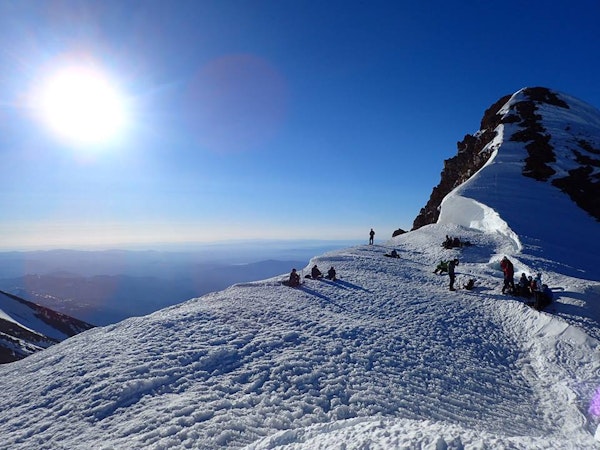
Sargents Ridge
Sargent’s Ridge is probably the most difficult accessible winter route to the summit of Mt Shasta and one of the most sustained. This seldom done route is quite a challenge in the winter.
During the winter, the approach begins at Bunny Flat trailhead. From here, you will hike along the road (which does not get plowed in the winter) and begin heading up a ridgeline, which appears to your right.
Sargents Ridge continues to gain in elevation, including a few traverses, until you reach Shastarama Point, which offers some spectacular views. You will then hike along the top of the point until you reach Mud Creek Glacier, which is the best spot to camp for the night.
From Mud Creek Glacier, you will continue to ascend until Sargents Ridge meets Green Butte ridge. This is where the proper climbing begins. You will head to the right side of the ridge and begin a steep traverse up toward the top of the ridge, climbing over ice and rock as you go.
Farther along, you will make your way over the top of the ridge and cross over to its western side, making your way toward Thumb Rock. To get here, you can either stay higher up on the ridge or drop farther down. Staying higher up is more challenging, especially in non-ideal weather conditions but saves a lot of elevation gain and loss. During the winter, staying lower is generally better.
Once you’ve reached Thumb Rock, the climb gets a bit easier. You will head along the Red Banks ridgeline until the top of Misery Hill. From here, you can see the true summit of Mt Shasta and it is a long, scrambling ascent over ice and rocks until you reach the top.
You will descend from the same route you came up.
Casaval Ridge
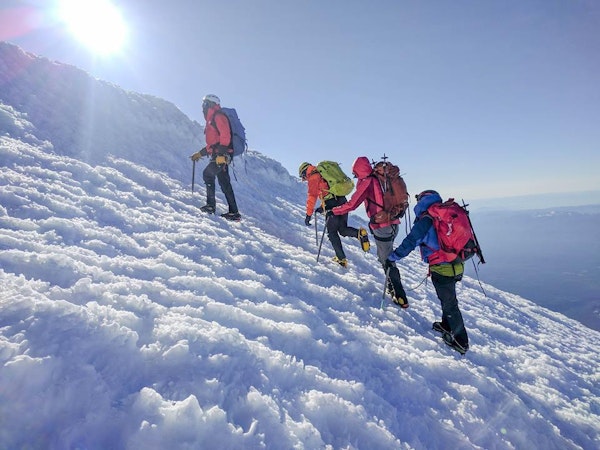
Forming the southern spine of Mt Shasta, Casaval Ridge is one of the most prominent ridges on the mountain.
While the most aesthetically pleasing route up to the summit, it is also one of the toughest, with traverses up steep slopes and some relatively exposed parts as well.
That being said, Casaval Ridge is generally the best route for winter mountaineering and is, in fact, best climbed with a large snowpack.
Starting from Bunny Flat trailhead, climbers will hike up to the Sierra Club Hut before continuing north toward the start of the Casaval Ridge.
Once you’ve arrived at the start of the ridge, you will begin the proper climbing over some rocks and ice. This part seems shorter than it is, and once you’ve reached the top, you will be at a flat part. Many climbers will camp here for the night and begin for the summit early the next morning.
You will make your way from here up along a wide slope until the start of the ridge proper. This part is relatively flat, but also poses the largest avalanche risk on the route. Check snow conditions prior to climbing.
Once you have arrived at the ridge proper, you will head along the west side of the ridge, trekking through deep snow. You will then come to the steepest part of the route, where you will be required to climb over several rock bands until you reach another flatter section. This is usually the toughest part of the climb and the most exposed.
Once up atop the flat part you will hike along to the start of the Red Banks and follow the route described for Sargents Ridge.
Descending via Sargents Ridge is the most common way down as well.
Join SWS Mountain Guides on a 3-day winter ascent to Mt Shasta via the Casaval Ridge!
How Hard Is It to Climb Mt Shasta?
Winter mountaineering expeditions on Mt Shasta are quite challenging, but far from impossible, according to Timothy:
“It is not ‘easy’ to climb Mount Shasta in the winter. There are technical challenges, steep snow, traverses, but the technical challenges are not difficult.”
“What is more difficult or ‘hard’ is the mountaineering judgement you have to have in regards to weather, avalanche danger and route finding,” he added.
Regardless of the time of year you are climbing, a high level of physical fitness is required to summit the mountain. Roughly 15.000 climbers attempt to summit the peak each year. Of those, about one-third succeed.
Not only does the climb take place at altitude, but it requires carrying a fair amount of gear up steep sections for hours at a time. Make sure you are in appropriate physical condition prior to booking your trip.
What Are the Weather Conditions in Mt Shasta During Winter?
“Climbing Mount Shasta in the winter can be a very dangerous proposition, with a very small window for error in judgement,” Timothy said.
Part of the reason for this is how extreme the weather can be, which is particularly difficult on some of the more exposed sections of the climb. An abundance of wind and snow can also complicate the climbing process.
“Weather can be extreme with winds in excess of 100 plus miles per hour and subzero temperatures,” Timothy said. “Plus, the mountain can receive large amounts of snow in a very short period of time — creating extreme avalanche danger.”
Overall, Timothy recommends undertaking a winter mountaineering expedition in February or March. At this time of year, you should expect temperatures of around -15 °C, not including windchill on the mountain. The peak also gets an average of 100 millimeters of snow per month during this time of year.
What Equipment Do I Need to Climb Mt Shasta?
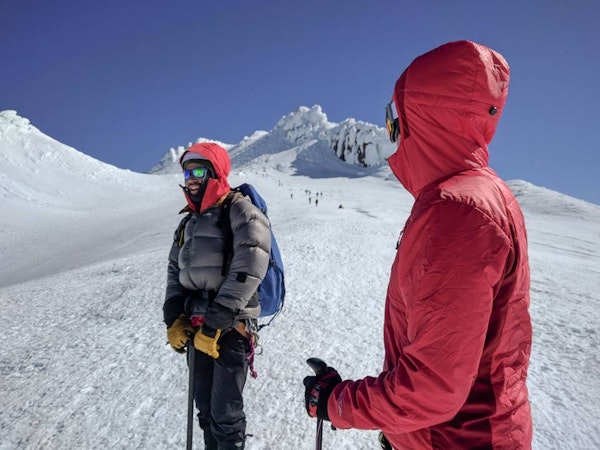
The following equipment is all of what Timothy recommends you bring on a winter ascent of Mt Shasta. Items with an asterisk (*) behind them are things he provides for his clients.
Avalanche probe*
Avalanche transceivers*
Climbing rope*
Cooking stoves*
Crampons*
Four-season tent*
Helmets*
Ice axes*
Mountaineering boots
Snow pickets*
Snowshoes
Wands*
Winter thermal sleeping bag and sleeping pad
60 to 80 liter pack
In terms of clothing, it is important to dress in layers and bring plenty of waterproof items as well. In general you will want to have shell jackets and pants; liner gloves and outer gloves; snow goggles and sunglasses; knit caps and sun hats; wool or synthetic long underwear; and multiple pairs of wool socks, among other necessary items you would bring on any mountaineering expedition.
Timothy provides his clients with a complete checklist prior to heading out on a winter mountaineering expedition. Be sure to double check that list prior to heading out to Mt Shasta.
How Much Does It Cost to Climb Mt Shasta?
SWS Mountain Guides charge $845 per person for a winter mountaineering expedition to the summit of Mt Shasta. This price includes the guiding fee, all of the group and safety equipment, camping equipment and permit fee to climb the mountain.
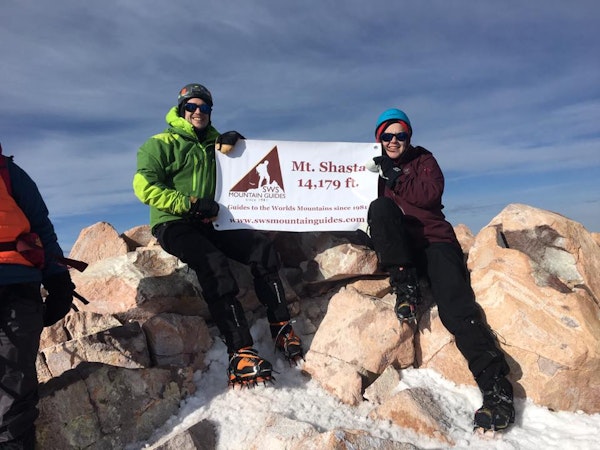
However, climbing Mt Shasta in the winter is certainly worth all of the effort and preparation. Views from the top are sublime and the experience is one of the best you’ll get in California.
“With risk comes reward", Timothy said and added that the highlights of climbing Mt Shasta are "isolation, extreme conditions and extreme beauty.”
Winter mountaineering expeditions to the summit of Mt Shasta are the perfect way to see this sublime part of California as well as excellent preparation for more difficult ascents in taller mountain ranges.
Book your next winter mountaineering adventure now and prepare for this fun and exhilarating ascent!
